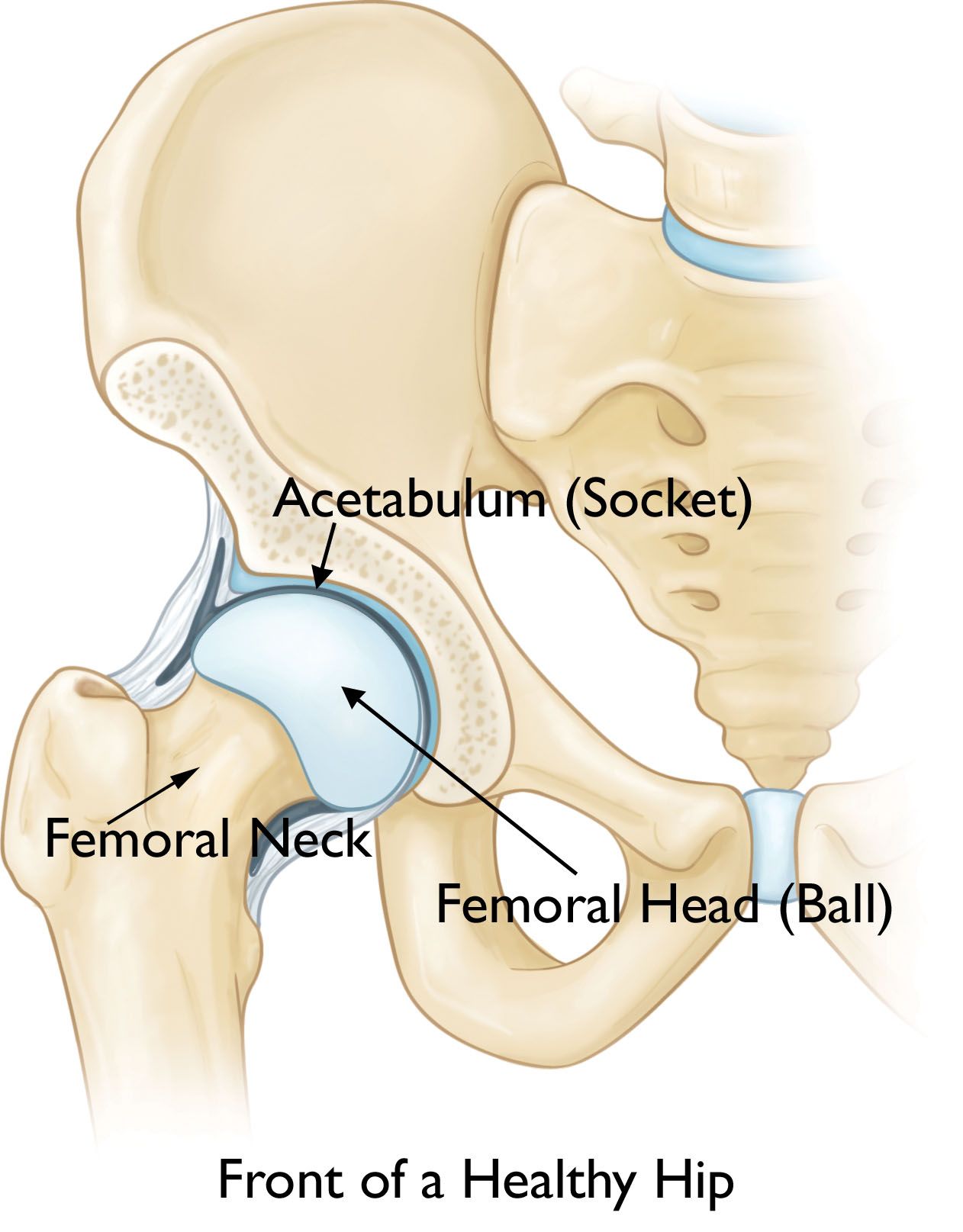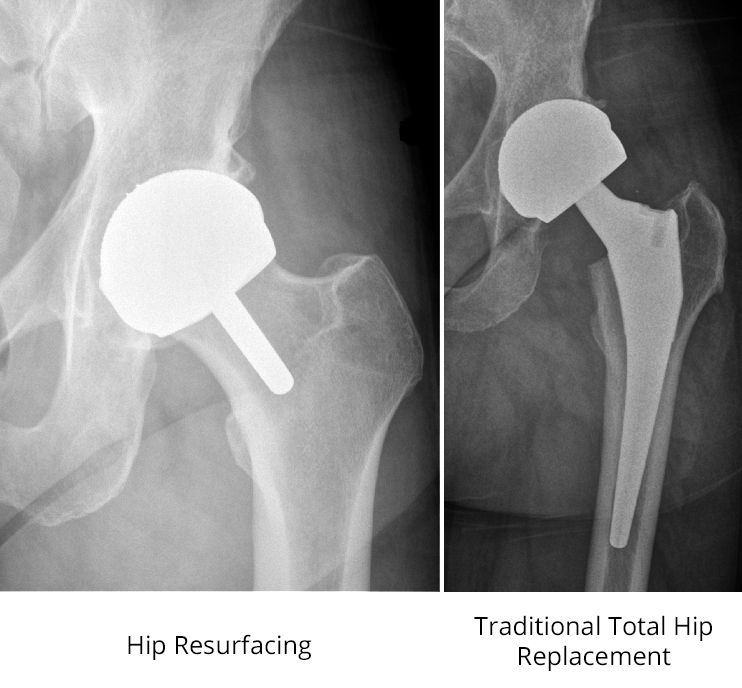Treatment
Hip Resurfacing
Patients with advanced arthritis of the hip may be candidates for either traditional total hip replacement (arthroplasty) or hip resurfacing (hip resurfacing arthroplasty). Each of these procedures is a type of hip replacement, but there are important differences. Your orthopaedic surgeon will talk with you about the different procedures and which operation would be best for you.
Description
In a traditional total hip replacement, the head of the thighbone (femoral head) and the damaged socket (acetabulum) are both removed and replaced with metal, plastic, or ceramic components.
In hip resurfacing, the femoral head is not removed but is instead trimmed and capped with a smooth metal covering. The damaged bone and cartilage within the socket are removed and replaced with a metal shell, just as in a traditional total hip replacement.
Advantages of Hip Resurfacing
The advantage of hip resurfacing over traditional total hip replacements is an area of controversy among orthopaedic surgeons. Research is currently being done on this topic.
- Hip resurfacings may be easier to revise (redo). Because the components (called implants) used in hip replacements and hip resurfacings are mechanical parts, they can — and do — wear out or loosen over time. This typically occurs 15 to 20 years after the procedure, although implants may last longer or shorter periods of time.
If an implant fails, an additional operation may be necessary. This second procedure is called a revision, and it can be more complicated than the initial operation. Because hip resurfacing removes less bone from the femur (thighbone) than a traditional hip replacement, many surgeons believe it is easier to exchange implants that fail after hip resurfacing.
- Decreased risk of hip dislocation. In hip resurfacing, the size of the ball is larger than in a traditional hip replacement, and it is closer to the size of the natural ball of your hip. Because of this, it may be harder to dislocate. This stance is controversial because several factors can affect the risk of dislocation, including the surgical approach, and the type and size of the implants used.
- More normal walking pattern. Some studies have shown that walking patterns are more natural following hip resurfacing compared to traditional hip replacement. These differences in walking are quite subtle, however, and special instruments are needed to measure them.
Disadvantages of Hip Resurfacing
- Femoral neck fracture. A small percentage of hip resurfacing patients will eventually break (fracture) the thighbone at the femoral neck. If this occurs, it is usually necessary to convert the hip resurfacing into a traditional hip replacement.
A femoral neck fracture is not possible with a traditional hip replacement because the femoral neck is removed during this procedure. However, fractures around the implants can still occur with a traditional hip replacement. - Metal ion risk. In hip resurfacing, a metal ball moves within a metal socket. Over time, the friction between the two surfaces can lead to the release of tiny metal molecules called ions. The ions can cause a reaction in the bone and soft tissues surrounding the joint called an adverse local tissue reaction. This can cause pain and swelling and may lead to the need for revision surgery. The ions may also enter the bloodstream and have systemic (body-wide) effects. For this reason, hip resurfacing is now performed less frequently than in the past.
Some types of traditional hip replacements also consist of a metal ball and a metal socket, and these replacements run the same potential risks.
Ask your doctor for more information about metal-on-metal implants.
Candidates for Surgery
Your doctor may recommend surgery if you have more advanced osteoarthritis and have exhausted the nonsurgical treatment options. Surgery should only be considered if your hip symptoms are significantly affecting the quality of your life and interfering with your normal activities.
Unlike hip replacement, hip resurfacing is not suitable for all patients. Generally speaking, the best candidates for hip resurfacing:
- Are younger (less than 60)
- Have larger-framed patients (often, but not always male)
- Have strong, healthy bone
Patients who are older, female, and smaller-framed, with weaker or damaged bone are at higher risk of complications, such as femoral neck fracture.
A comprehensive evaluation by your orthopaedic surgeon will help you determine if you are a good candidate for hip resurfacing.
Your Surgery
Before Surgery
You will likely be admitted to the hospital on the day of surgery.
Before your procedure, a doctor from the anesthesia department (anesthesiologist) will evaluate you. They will review your medical history and discuss anesthesia choices with you. You should also have discussed anesthesia choices with your surgeon during your preoperative clinic visits. Anesthesia can be either:
- General (you are put to sleep)
- Regional (you are awake, but your body is numb from the waist down)
Your surgeon will also see you before surgery and sign your hip with a marker to verify the surgical site.
Surgical Procedure
A hip resurfacing operation typically lasts from 1-1/2 to 3 hours. During the procedure, your surgeon will:
- Make an incision in your thigh to reach the hip joint.
- Dislocate the femoral head out of the socket.
- Trim the head with specially designed power instruments.
- Cement a metal cap over the prepared femoral head.
- Use a power tool called a reamer to remove the cartilage that lines the socket.
- Push a metal cup into the socket; the cup is held in place by friction between the bone and the metal.
- Once the cup is in place, position the femoral head back into the socket, and close the incision.
After surgery, you will be taken to the recovery room, where you will be closely monitored by nurses as you recover from the anesthesia. You will then be taken to your hospital room.
Complications
As with any surgical procedure, there are risks involved with hip resurfacing. Your surgeon will discuss each of the risks with you and will take specific measures to help avoid potential complications.
Although rare, the most common complications of hip resurfacing are:
- Infection. You will be given antibiotics before the start of your surgery and these will be continued for about 24 hours afterward to prevent infection.
- Blood clots. Blood clots can form in the deep veins of the legs or pelvis after surgery. Blood thinners, such as rivaroxaban (Xarelto), enoxaparin (Lovenox) or warfarin (Coumadin); aspirin; or other drugs can help prevent this problem.
- Injury to nerves or vessels. Although it rarely happens, nerves or blood vessels may be injured or stretched during the procedure.
- Femoral neck fracture
- Dislocation
- Risks of anesthesia
Recovery
In most cases, patients go home 1 to 4 days after surgery.
You may begin putting weight on your leg immediately after surgery, depending on your doctor's preferences and the strength of your bone. You may need a walker, cane, or crutches for the first few days or weeks until you become comfortable enough to walk without assistance.
You can expect some pain and discomfort for several weeks after surgery. Your doctor may prescribe pain medicine, if needed.
Many types of pain medication are available to help control pain, including opioids, nonsteroidal anti-inflammatory drugs (NSAIDs) and local anesthetics. Treating pain with medications can help you feel more comfortable, which will help your body heal faster and recover from surgery faster.
Opioids can provide excellent pain relief; however, they are narcotics and can be addictive. It is important to use opioids only as directed by your doctor and to stop taking these medications as soon as your pain starts to improve.
Your doctor may recommend physical therapy after surgery. The physical therapist will give you exercises to help maintain your range of motion and restore your strength. You will continue to see your orthopaedic surgeon for follow-up visits in their clinic at regular intervals.
You will most likely resume your regular activities of daily living by about 6 weeks after surgery.
Contributed and/or Updated by
Peer-Reviewed by
AAOS does not endorse any treatments, procedures, products, or physicians referenced herein. This information is provided as an educational service and is not intended to serve as medical advice. Anyone seeking specific orthopaedic advice or assistance should consult his or her orthopaedic surgeon, or locate one in your area through the AAOS Find an Orthopaedist program on this website.









